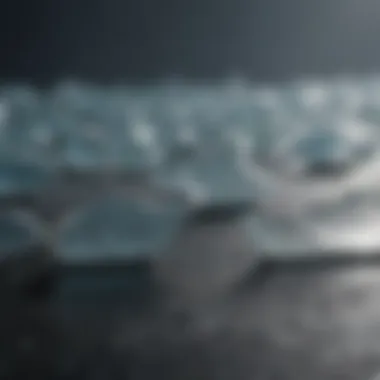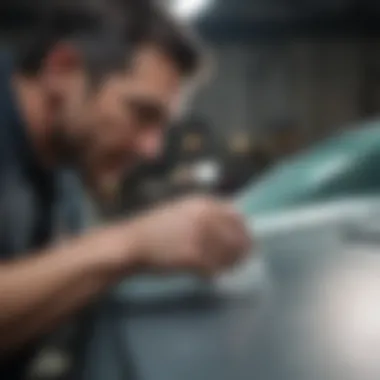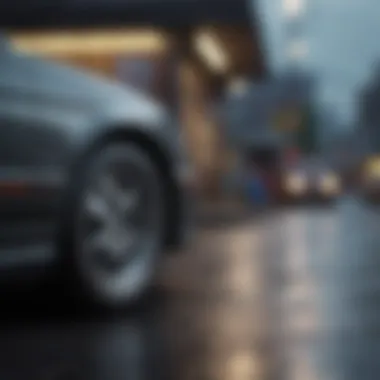Understanding Windshield Chip Repair: Key Insights


Intro
Windshields play a crucial role in vehicle safety, but they are not immune to the wear and tear of everyday driving. A seemingly minor issue, such as a chip, can pose significant consequences if not addressed properly. The decision to repair or replace a damaged windshield isn’t always straightforward. It involves evaluating several factors like the type of chip, safety implications, repair methods, and even cost considerations. This article aims to demystify these aspects, making it easier for vehicle owners to make informed choices.
Vehicle Purchasing Behavior
Understanding how consumers behave when purchasing vehicles is essential to fully grasp the implications of windshield chip repair. Many buyers prioritize safety features, which includes the integrity of a windshield. When making a decision, they often weigh factors that influence their choice significantly.
Factors Influencing Vehicle Purchases
When it comes to purchasing vehicles, several elements tend to steer decisions. Here are some notable factors:
- Safety Ratings: Consumers are increasingly aware of safety ratings. A vehicle's safety features, including windshield durability, often play a critical role.
- Cost of Maintenance: Prospective buyers might factor in long-term costs, like repairs and insurance. A windshield that can be easily repaired may influence buyer decisions favorably.
- Environmental Impact: There's a growing trend among buyers to consider the environmental ramifications of their purchase choices. Vehicles with a focus on sustainability can appeal to this demographic, including those that prioritize less waste, such as minimizing landfill contributions from broken glass.
Demographics of Buyers
Analyzing who purchases vehicles provides further insight into buying behavior. Different demographics have unique preferences:
- Millennials: Often seek innovative features and sustainability. They might prioritize brands known for green alternatives or advanced safety technologies.
- Baby Boomers: Typically, they value reliability and safety. An easily repairable windshield could be a significant selling point for this group, who are more likely to be concerned about accidents.
- Family Buyers: Families aim for vehicles that promise safety for children. Understanding that a windshield is sturdy and can be repaired might fill them with confidence when making a purchase.
As the market evolves, understanding these behaviors will ultimately help both sellers convey information more effectively and Buyers feel more secure in their investments. Making informed decisions about repairs like windshield chips can also be a reflection of a buyer's values towards safety and environmental responsibility in their vehicle choices.
Market Insights and Analysis
Recent market studies highlight how consumer behavior is shifting. As the knowledge about vehicle maintenance grows, the awareness regarding the importance of a windshield in overall safety has surged. Understanding this context can enhance the experience of potential customers, guiding them in not only the purchasing of vehicles but also in taking care of them post-purchase.
Consumer Behavior Analysis
Consumer attitudes towards windshield repair evolve with trends and information dissemination. Many potential buyers engage with various platforms, including forums like reddit.com or social media sites, where discussions surrounding repair versus replacement often take place. Engaging with such communities helps educate consumers. This demographic increasingly values transparency in the information they receive about repairs.
Competitor Analysis
With multiple companies vying for customer attention, it's vital to assess what competitors offer. For example, companies specializing in glass repair emphasize how certain chips can be fixed without the need for a full windshield replacement. By exploring competitors, businesses can uncover gaps in their services and capitalize on consumer pain points in chip repairs.
"An informed vehicle owner is a satisfied vehicle owner. Decisions made with clarity reflect in both safety and financial choices."
Consolidating all this information sheds light on the multi-faceted nature of windshield chip repair. Understanding consumer behavior is not just beneficial for sales; it journeys into how we prioritize safety and sustainability in our everyday lives. Through examining these critical elements, we find significant insights that relate not just to the vehicles themselves, but the humans driving them.
Understanding Windshield Chips
When it comes to automotive care, few things can disrupt a smooth drive quite like a windshield chip. Understanding windshield chips is far more than simply knowing that they exist; it’s about recognizing their impact on safety, visibility, and the integrity of your vehicle. This section lays the groundwork for comprehending the nature of these chips and their potential outcomes.
Windshield chips can happen without a moment's notice, usually caused by flying debris, temperature changes, or accidents. Ignoring them can lead to cracks that compromise the entire structure of the windshield, posing serious safety risks. This article serves as a guiding light for enthusiasts, buyers, and eco-conscious consumers, shedding light on what can be a surprisingly intricate issue.
Nature of Windshield Glass
Windshield glass isn’t just any glass; it’s specially designed to bear the brunt of impacts while maintaining integrity. Most car windshields are made of laminated safety glass, which consists of two layers of glass with a polyvinyl butyral (PVB) interlayer. This unique construction not only keeps glass shards from flying into the vehicle during an accident but also enhances the windshield's resilience against chips and cracks. Understanding this composition allows consumers to appreciate the factors affecting repairability.
Common Types of Chips
In the world of windshield chips, there isn’t a one-size-fits-all category. Various types of chips have their own distinct characteristics. Knowing these can significantly help in decisions about repair or replacement.
Bullseye
The bullseye chip resembles, well, a bullseye. It’s typically round with a dark center, which tends to form when a small object strikes the glass and creates a circular impact. This type of chip is considered less invasive, as it can generally be filled effectively. Their key characteristic is that they often maintain the structural integrity of the windshield, making them a popular choice for repair. The advantages here are ample; bullseye repairs are often quicker and less costly, allowing drivers to get back on the road without a hitch.
Star
Star chips possess a unique starburst pattern radiating outward, hence the name. Unlike bullseye chips, stars can develop multiple crack lines. While they are not as catastrophic in many cases, the presence of these lines can complicate the curing process. Recognizing star chips is crucial, as they can sometimes indicate a deeper issue. The primary advantage lies in their visibility; they can be less noticeable if repaired properly, maintaining the appearance of a well-kept vehicle.
Edge
Edge chips occur too close to the vehicle's periphery for comfort. Often originating from impacts at the edges of the windshield, these chips can impact the overall strength of the glass. Key to this type are considerations about safety, as edge chips may worsen over time, leading to further damage. Unfortunately, repairs on edge chips can sometimes be questionable, making it crucial for car owners to assess their options closely.
Combo
Combo chips are a hodgepodge of damage, incorporating features from multiple chip types. Their irregular appearance can pose unique challenges. The main takeaway is that combo chips can range from being somewhat repairable to requiring complete windshield replacement. This diversity complicates judgement and necessitates a thorough assessment. It’s this complexity that makes understanding each type of chip vital for effective decision-making.


"Knowing the specific type of chip is the first step to understanding your repair options."
Ultimately, grasping these distinctions can guide vehicle owners through the often murky waters of windshield maintenance and repair. Different styles dictate diverse approaches, which play a critical role in ensuring safety and longevity. Understanding windshield chips fully equips readers to tackle any issues they face, ensuring that their vehicle remains roadworthy.
Assessing Repair Viability
Determining whether a windshield chip can be repaired is a crucial step in the process. Not only does it influence the financial aspect for vehicle owners, but it also impacts safety and long-term vehicle integrity. The viability of repair hinges on several specific facets, each interlinked to the condition of the windshield and the chip itself. Evaluating the size, location, and timing of the damage are the primary considerations, and understanding these elements can save time and resources.
Size and Depth Considerations
One of the first factors to take into account is the size and depth of the chip. Generally, smaller chips tend to be easier and more effective to repair, while larger or deeper ones often necessitate replacement. As a rule of thumb, if the chip measures less than a quarter in size and is not too deep, it has a good chance of being fixable. The depth is equally important; chips that haven't penetrated all the way through the glass offer a stronger case for successful repairs. Careful measurements here can lead to significant cost savings and ensure the windshield's structural stability.
Location of the Chip
Driver's Line of Sight
The chip's placement in relation to the driver's line of sight plays a critical role in determining repair viability. Damage found directly in the driver's field of vision can create serious safety issues because it may impair the driver's view. Thus, while technically repairable, chips in these areas might be better left unaddressed through standard repair means, as increased distortion post-repair can limit operational safety. Drivers should recognize that visibility is paramount and take any visibility-affecting damage seriously.
Near the Edges
Chips located near the edges of the windshield present a different set of challenges. Unlike those within the driver's line of sight, chips at the edges are often regarded as more vulnerable and potentially compromising to the windshield's overall strength. Repairing a chip in this zone requires specialized techniques, as they can substantially impact the ability of the windshield to withstand impacts. Such chips may be deemed less favorable for repair, as even minor alterations can significantly undermine its integrity, necessitating closer evaluation before an attempt is made.
Time Since Damage Occurred
Finally, the duration since the damage took place is imperative to assess repair viability. Fresh chips, particularly those that haven’t been exposed to varying weather or temperature fluctuations, have a higher success rate when it comes to repairs. Conversely, older damage can gather dirt or debris, making it difficult for resin to adhere properly. Assessing how long ago the chip occurred could shed light on whether to go for a repair or straight to replacement. In short, timely action can lead to better outcomes and lesser costs.
"Waiting too long after a chip forms can not only hinder a successful repair but also affect overall windshield safety."
Repair Techniques Explained
Repair techniques for windshield chips play a crucial role in determining if a chip can be salvaged or if replacement is the only option. Understanding these techniques helps car owners make informed choices after assessing the damage to their windshields. This section dives into precise methods used in repairing, along with their respective benefits and considerations.
Resin Injection Process
The resin injection process, often viewed as the gold standard of windshield repair, involves treating the chip with a clear resin that restores strength and clarity to the damaged area. Essentially, this technique fills the void in the glass, helping to prevent the chip from spreading further. The importance of this method cannot be overstated; it not only helps maintain the structural integrity of the windshield but also minimizes visibility issues.
Here's a step-by-step breakdown of how it typically works:
- Preparation: The area around the chip is cleaned to ensure no dirt or debris interferes with the repair.
- Injection: Using a specialized tool, a technician injects resin directly into the chip. The resin penetrates the cracks and voids.
- Curing: The resin is then cured, typically using ultraviolet light, which hardens it to ensure a durable repair.
- Polishing: Finally, any excess resin is polished away, returning the surface to its original clarity.
This technique is all about precision and patience, and it can greatly extend the life of your windshield.
Vacuum Methods
Vacuum methods are yet another innovative approach to windshield chip repair. While the resin injection focuses more on filling the chip, vacuum methods take a slightly different angle, first removing any air from the damaged area. This process utilizes a specially designed tool that, as the name suggests, creates a vacuum around the chip. Here’s how it goes:
- Setup: A fitting device is placed over the chip to create a seal.
- Vacuum Application: A vacuum is created, pulling out air and moisture from the damaged area. This is crucial because if there are air bubbles in the chip, the repair won’t be effective.
- Resin Filling: Once the vacuum is established, resin is injected into the chip under pressure, ensuring that it fully penetrates the cracks.
- Curing: Like the resin injection process, the resin is cured for maximum bonding potential.
This method is particularly beneficial for larger cracks or complex chip patterns where mere filling isn't enough.
Post-Repair Testing
After any repair technique, it is vital to conduct post-repair testing. This step ensures that the windshield is not only visually appealing but also structurally sound. Several methods can be employed to check the efficacy of the repair:
- Visual Inspection: A trained technician will examine the area to ensure it meets standards for clarity and adhesion.
- Water Test: Spraying water on the repaired area can help determine if any leaks exist. If water seeps through, it indicates further action might be needed.
- Pressure Test: Some shops employ pressure techniques to assess the strength of the repair, ensuring it can withstand external forces.
By conducting thorough post-repair testing, car owners can rest assured that their repair efforts have paid off and that their windy shield is as good as new.
Safety Considerations
When it comes to windshield chip repair, safety is a paramount concern. Understanding how a cracked or chipped windshield can impact the vehicle's structural integrity and the effectiveness of safety mechanisms like airbags is crucial. A chip might seem innocuous at first glance, yet it can pose significant risks that shouldn’t be overlooked. If not addressed properly, a damaged windshield can lead to severe consequences.
Structural Integrity of Windshield
The first aspect to consider is the structural integrity of the windshield itself. Windshields are not just panes of glass; they are vital components that contribute to the overall strength and safety of the vehicle. In a collision, a compromised windshield may not provide adequate support to the frame of the car, potentially resulting in greater damage to passengers inside.
- Strength Factors: A solid windshield helps to keep the cabin secure during a crash. If there are chips or cracks, the risk of the glass shattering increases during sudden impacts.
- Stress Distribution: Windshields are designed to distribute stress evenly. A chip can disrupt this distribution. For instance, a star break may seem small but can affect the appliance of pressure across the entire structure.


Regular inspections can help in spotting early signs of damage. If a chip is found, immediate action is advised. Waiting too long can turn a minor repair into something riskier than a mere chip repair.
"A little crack can lead to a big problem."
Airbag Deployment Factors
Next, the relationship between windshield integrity and airbag deployment cannot be taken lightly. Modern airbag systems rely on the structural components of the vehicle to function effectively. A damaged windshield could affect the way these safety features activate, possibly leading to malfunction during critical moments.
- Positioning: The windshield aids in the correct positioning of airbags. In an accident, if the windshield is compromised, the airbag may not deploy properly, which can be catastrophic.
- Impact Dynamics: The way impact forces are distributed changes depending on the kind of damage present on the windshield. The risks of misfunctioning systems increase significantly with chip damage that worsens over time.
For the safety of the driver and passengers, it's essential to be aware of the condition of your windshield. Ignoring minor chips may lead to increased risk and potentially dire outcomes. Always keep an eye out for changes and seek professional help where necessary.
Cost Implications
Understanding the financial aspects surrounding windshield chip repair is crucial for making informed choices. Repairing a chip in your windshield can save you a chunk of change compared to outright replacement, but this isn’t a straight path filled with savings. Let’s break it down, piece by piece, shedding light on what you can expect when it comes to costs.
Repair vs. Replacement Costs
When you find yourself facing a windshield chip, the first question that typically pops up is whether to repair or replace. Repairing a chip usually costs less than replacing the windshield—often falling between $50 to $150 based on location and extent of damage.
- Cost Overview of Repair
The repair moment comes with several benefits. For instance:
- Quick service times, often less than an hour.
- Maintaining the original windshield avoids any potential fitment issues with a new one.
- Prevents further damage from occurring, which could lead to a pricier replacement.
In contrast, replacing a windshield can vary widely, sometimes landing between $200 and $1,000 or more, depending on the vehicle type, model, and labor costs. Here are some elements to consider:
- Type of vehicle: Luxury models tend to bear higher costs.
- Glass quality: OEM (Original Equipment Manufacturer) glass generally comes with a heftier price tag.
- Labor and installation fees, which can differ significantly by region.
Comparatively, if you let a chip slide for too long—turning into a crack—the cost of replacement rises. It's a classic "penny wise, pound foolish" situation; a little upfront cost for a repair can save you a significant hit down the line.
Insurance Coverage Aspects
Insurance is another layer that can significantly influence the cost implications of windshield chips. Many insurers offer coverage for repairs—and some even waive the deductible.
- Key Points in Coverage
- Collision Coverage: If you have it, repairs typically fall under this—providing you peace of mind without digging into your pocket.
- Comprehensive Coverage: This often covers windshield damage; however, many policies might require you to pay the deductible first if opting for a replacement.
- State Laws and Insurance Variances: Location also impacts coverage. Some states mandate insurers to cover repairs wholly, without deductibles, making it easier for drivers.
"It's wise to go through your insurance policy; sometimes, you could end up paying far less than expected, especially if the damage is minimal."
Ultimately, weighing your options can help you navigate these financial waters. A careful approach ensures that whether through repair or replacement, you're hitting the right balance between cost and necessary safety—ensuring a clear view of the road ahead without unnecessary financial burdens.
Environmental Impact
The environmental implications of windshield chip repairs can’t be ignored, especially in today’s eco-conscious world. As our society becomes more aware of the footprints we leave behind, even small choices like repairing or replacing a windshield play a significant role. In this section, we will delve into two key aspects that highlight just how important it is to consider environmental impact when making decisions regarding windshield damage.
Material Reusability
One of the top benefits of fixing, rather than replacing, a damaged windshield is the potential for material reusability. When a windshield is repaired, there's less waste produced compared to a complete replacement. Typically, a windshield consists of laminated glass that can be tricky to recycle effectively due to its mixed materials.
However, when you repair a chip, it extends the lifecycle of that glass. This means that instead of tossing out an entire windshield—which often ends up in landfills—you're preserving those materials for longevity.
It also lessens the demand for new resources that would otherwise be needed to create a completely new windshield.
In terms of environmental responsibility, it’s like putting your waste on a spring diet; the less you throw away, the better it is for Mother Earth.
Waste Reduction Through Repair
Repairing a windshield chip also contributes significantly to waste reduction. Replacing a windshield not only results in the disposal of the broken glass but frequently includes other materials such as adhesives and vinyl trim, which might not be recycled effectively.
Through repair methods—like resin injection—the fall-out of e-waste is minimized. Going down this route can lead to:
- Reduction in landfill space: Every repaired windshield means one less piece of waste taking up valuable landfill space.
- Lower environmental footprint: Fewer resources are required when existing materials are used to fix chips rather than manufacturing entirely new windshields.
"Every chip repaired is a small step towards reducing our ecological footprint and conserving our planet's precious resources."
Thus, choosing the repair route represents not just a money-saving opportunity but also an ethical decision that reflects concern for the planet. You potentially decrease your environmental impact with every small repair.
Ultimately, combining these aspects paints a vivid picture of how windshield chip repairs aren’t just practical—they’re a sound choice for our environment too. By understanding these implications, vehicle owners can feel more informed and responsible in their decision-making.


Common Misconceptions
In the realm of windshield repair, a few shadows are cast by deep-rooted misconceptions that tend to complicate the decision-making process. It's essential to dissect these myths, as understanding the truths behind them can save you time, money, and even safety hazards. Misconceptions can shape repair approaches, influence consumer choices, and ultimately determine whether a simple chip needs professional attention or an entire replacement. Here's a closer look at some prevalent fallacies surrounding windshield chip repair.
Myth: All Chips Are Fixable
This myth is one that gets tossed around all too often. Many folks cling to the hope that any chip or crack can simply be filled with resin and fixed right up. However, the reality paints a more complicated picture. Certain types of damage, like a significant crack that spreads across the windshield or one that compromises the structural integrity of the glass, may not lend themselves to repair.
When considering fixing a chip, size and location come into play. Chips over a quarter-inch in size or those situated in critical areas—especially the driver's line of sight—are generally deemed non-repairable.
Moreover, even some 'smaller' chips can morph into larger cracks as temperature changes occur or the vehicle goes over bumps. In such cases, a seemingly harmless chip can transform into a significant issue in a blink of an eye. This points to the necessity of a thorough assessment by a professional who can determine the feasibility of repair.
Myth: Repair Is Always Cheaper
There's an alluring simplicity in thinking that repair is the go-to option because it typically seems like a cheaper route. But let’s pump the brakes for a second. The truth isn't that straightforward.
The cost of repair may initially tingle the wallet less than a full windshield replacement, but various factors play into the final cost. For instance, if multiple chips exist or the damage is deemed non-repairable, then jumping straight to a replacement might be the most logical, albeit pricier, solution in the long run.
Additionally, insurance coverage can significantly affect the financial equation. Some policies may cover repairs at no out-of-pocket cost, while others might place a lower value on repair compared to replacement. Thus, assessing your policy conditions becomes vital before making a hasty decision.
"What looks cheaper on the surface can sometimes sink your funds deeper than expected."
Consumers need to keep a wary eye on the assumptions they make regarding cost. An informed decision involves not just looking at the immediate price tag but considering the factors that may impact the overall expense of maintaining windshield integrity.
Expert Recommendations
In the realm of windshield repair, expert recommendations serve as a cornerstone for decision-making. These insights help consumers navigate the often murky waters of whether to repair or replace their damaged windshields. It's crucial to recognize that while DIY solutions may seem tempting, there are significant factors to weigh before making such decisions. The guidance from seasoned professionals is rooted in a deep understanding of materials, safety standards, and the complexities of repair techniques.
When to Seek Professional Help
Knowing when to call in the pros can save you time, money, and headaches down the line. If the chip or crack is larger than a quarter, has penetrated more than one layer of glass, or is located in the driver's line of sight, professional assistance is often your best bet. These situations may pose serious risks not only to the integrity of the windshield but also to overall vehicle safety.
Consider this:
- If you notice any spreading of the chip, it’s an indicator that the damage may worsen, and immediate professional evaluation is warranted.
- A delay in seeking help can lead to additional costs should the damage escalate beyond repairable size.
Additionally, if you’re uncertain about the repair process, it’s better to err on the side of caution. Professional services often utilize advanced techniques and equipment that DIY kits can’t match, ensuring higher-quality results.
DIY Approaches: Pros and Cons
Opting for a DIY approach might appeal to those looking to save a few bucks, but it’s worth considering the pros and cons thoroughly.
Pros:
- Cost-effective: DIY kits are generally cheaper than professional services, making them an attractive option for small chips.
- Convenience: Repairing a chip at home can be done on your own schedule—no need to take time out of your day to visit a repair shop.
Cons:
- Quality of repair: Home repairs may not provide the durability and transparency that professionals can guarantee, leading to potential visibility issues.
- Risk of worsening damage: If the repair isn’t done properly, it could exacerbate the situation, transforming a small chip into a larger issue that requires professional intervention.
Maintaining Windshield Integrity
Maintaining the integrity of your windshield is crucial for both safety and functionality. The windshield serves as a primary barrier against debris, wind, and the elements while also being an integral part of your vehicle’s structural support system. Even minor chips can compromise this integrity, potentially leading to larger cracks or shatters if not addressed properly. Consequently, ensuring that your windshield remains in top condition can save you from expensive repairs and ensure that your vehicle is safe for you and your passengers.
Several factors come into play when considering windshield integrity. Understanding these can empower drivers to take proactive measures. For instance, environmental elements such as temperature fluctuations can cause existing chips to expand, making early inspections a priority.
It’s also worth noting that a well-maintained windshield enhances visibility, promoting safer driving conditions. Clear visibility can make a considerable difference in emergency situations where quick reflexes are required. In short, maintaining your windshield is not merely about aesthetics; it’s about safeguarding human lives.
Routine Inspections Tips
Routine inspections of your windshield do not have to be a chore. Here are some tips to help you stay on top of it:
- Visual Checks: Make it a habit to visually examine your windshield when you get into your car. Look for any new chips or cracks, no matter how tiny they may seem.
- Check Immediately After Impact: After an incident where your car may have been hit by stones or debris, give your windshield a closer inspection.
- Rubber Seals Inspection: Look at the rubber seals around your windshield. If they show signs of wear or if moisture seeps in, it could lead to hidden damage.
- Professional Evaluation: Periodically have a professional evaluate your windshield, especially if you notice any changes in your vision while driving.
Remember, it’s much easier—and cheaper—to fix a small chip than to replace a broken windshield. The objective here is to catch any potential problems before they escalate.
Protective Measures and Products
Taking preventive steps can make a world of difference in maintaining your windshield’s integrity. Here are several protective measures and products to consider:
- Windshield Covers: Using a windshield cover can prevent ice buildup in winter and shield your glass from heat in summer, reducing the risk of cracks.
- Quality Wipers: Invest in high-quality windshield wipers that do not damage the glass surface. Worn-out wipers can scratch your windshield over time.
- Glass Coatings: Some products are designed to provide a protective layer to your windshield, making it less susceptible to chips and cracks. These coatings can enhance water runoff as well, improving visibility during rain.
- Drive Carefully: Lastly, it might sound simple, but driving cautiously in areas prone to debris can significantly reduce the likelihood of damaging your windshield.
Ultimately, protecting your windshield involves a mixture of routine inspections and investing in good products.
Remember: A stitch in time saves nine; catching a small issue now can save you big headaches and costs in the future.















